Dyslexia is a common learning difficulty that primarily affects a person’s ability to read, write, and spell. Despite having normal intelligence, children with dyslexia may struggle with language processing, making everyday academic tasks challenging. Early recognition is crucial for providing the right support.
In this article, we’ll explain what is dyslexia, its causes, key symptoms, and how to recognize it early—especially in children.
What Is Dyslexia?
Dyslexia is a neurological learning disorder that affects the brain’s ability to process written and spoken language. It is not a sign of low intelligence or poor vision; rather, it's a difference in how the brain interprets language.
Children with dyslexia often have difficulties with:
- Reading fluently
- Spelling correctly
- Writing clearly
- Remembering sequences (like days of the week or the alphabet)
Common Causes of Dyslexia
While the exact cause of dyslexia is not fully understood, several factors are believed to contribute:
- Genetics: Dyslexia often runs in families.
- Brain Structure and Function: Imaging studies show differences in how the dyslexic brain processes language.
- Premature Birth or Low Birth Weight: These factors may affect brain development.
- Environmental Factors: Poor early language exposure can increase the risk of learning difficulties.
Symptoms of Dyslexia
The symptoms of dyslexia vary with age. Below are common indicators by age group:
Preschool Age:
Delayed speech development
- Difficulty learning new words
- Problems with rhymes and nursery songs
- Trouble recognizing letters
School Age:
- Slow or inaccurate reading
- Poor spelling and writing
- Avoiding reading aloud
- Confusing similar letters like b/d or p/q
- Difficulty remembering sequences or instructions
Teenagers and Adults:
- Reading slowly or with effort
- Struggling to summarize stories
- Avoiding reading and writing tasks
- Limited vocabulary growth
Early Signs of Dyslexia
Identifying dyslexia early helps children get the support they need before falling behind. Look for these early signs:
- Trouble learning the alphabet
- Difficulty with phonics (matching letters to sounds)
- Struggles to pronounce long or unfamiliar words
- Frequent reversal of letters or words
- Difficulty learning songs or rhymes
- Family history of reading or learning difficulties
How to Help a Child with Dyslexia
- Seek a professional assessment from a psychologist or learning specialist.
- Use structured literacy programs like Orton-Gillingham.
- Incorporate multisensory learning methods (visual, auditory, tactile).
- Build self-esteem through encouragement and celebrating small successes.
- Collaborate with teachers to adapt classroom instructions.
Final Thoughts
Dyslexia is a lifelong condition, but with the right support, children can thrive in school and beyond. Recognizing the early signs of dyslexia and taking action with tailored interventions makes all the difference. If you suspect your child may have dyslexia, don’t wait—get a professional evaluation and explore learning support options available near you.



